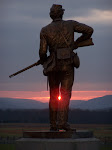
Posted: 04/18/2009 10:51:26 PM EDT
Propped up against the skull of what probably was once an animal, a child's rusted toy truck sits covered in mud at the bottom of a cardboard box. Soon, the box's contents grow to include several glass Gum Turpentine bottles, a busted butter dish, ink wells and what's left of a mechanical clock. "When they say this stuff never goes away, they are not kidding," Paul Mason says as he dumps yet another glass Clorox bottle into the box.Then, Mason resumes digging in the same spot which he and others concluded must have once served as the Spangler Farm's dumping ground. They might not be Civil War artifacts, but the random household items that date back a number of decades still are a pretty cool find, the group decides.
Not everyone who volunteered Friday for the clean-up project was lucky enough to retrieve something that had for years been buried in the ground. Most of the 300 volunteers spent the morning and afternoon simply clearing decades worth of brush and tree growth from parts of the 80-acre property.
But conversations across the farm always seemed to steer back to what someone found over here or over there. Once a hospital for wounded Union and Confederate troops during the Battle of Gettysburg, the Spangler Farm was in private hands until last year when the nonprofit Gettysburg Foundation bought it for $1.9 million.
Some historians believe Confederate Brig. Gen. Lewis A. Armistead died there in a small outbuilding known as the summer kitchen. A farmhouse and barn, both of which date to the time of the battle, also are on the property.
The farm remained largely untouched until Friday, when tourism professionals from across the country there for the annual Tourism Cares project, hosted this year by the Gettysburg Foundation at the Spangler Farm. Since its start in 2003, Tourism Cares has restored historic sites throughout the country.
Courtney Farfaglia and Julie Dorsey said they got a little more than they bargained for when the two Niagara University students were clearing brush and piles of old floorboards behind one of the property's non-historic buildings.
At the bottom of a pile was a door, built into the ground, that no one anticipated would be there. "It would be cool if it was a trap door for slaves or something," Dorsey said. It also might be a well, a storm-cellar door or something else. But it has the potential to be historically significant, said Gettysburg Foundation spokeswoman Dru Neil.
"We don't know what it is," she said. "We want to get the (Gettysburg National Military) Park in soon and help us determine what that is." The same goes for the other objects volunteers found on Friday, Neil said. "Anything we found, we're reporting."
As for the numerous bones found all over the property, Neil said they too would be examined. "Chances are they're animal bones," she said. "But we'll double-check just to be sure."
For the volunteers, a significant part of the workday was spent clearing brush from around the property's hundreds of trees. Now, professionals will be able to cut down the trees that weren't there in 1863. That's because the Foundation's ultimate goal is to restore the farm to its appearance at the time of the battle and open it to visitors for educational programs, Neil said. But there's a lot that remains to be done before then - even after Friday's clean up. A tree line bordering part of the property needs to be removed. The structural integrity of the barn also needs to be examined, Neil said.
"This is step one," she said. "What we really want to do is get visitors out here."
In the last year, Neil said, park historians have had a chance to examine the property, identify areas of historical significance and pinpoint trees that need to be removed. That research provided the guidelines for Friday's project, Neil said. "We would have never started this without guidance," she said.
Aside from general cleaning, Neil said volunteers mostly stayed away from the barn, summer kitchen and house. Eventually, the park will conduct historic structure reports on the buildings. "We don't want to take anything down that might be historic," Neil said.









No comments:
Post a Comment